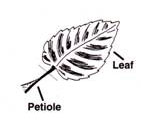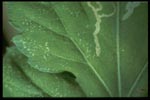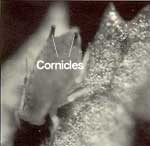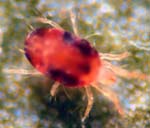Another key concept of Integrated Pest Management is damage recognition. Learn to diagnose insect and mite damage in your landscape.
Know the Causes of Foliage Injury
- Physical damage (breakage, sunburn)
- Plant diseases (viruses, fungi, bacteria)
- Arthropod pests (sow bugs, pill bugs, millipedes, insects, mites)
- Slugs and snails
- Vertebrates (rabbits, squirrels, deer, etc.)
Inspect for Arthropods
- Do a visual inspection of random leaves, particularly of underside of leaves
- Beating plant parts on an off-white card
- Yellow sticky traps attract flying adult aphids, whiteflies, leaf miners, fungus gnats, shore flies near plants
Learn to Recognize Feeding Patterns
Arthropod pests, including insects and spider mites, in the landscape produce characteristic damage related to the way they feed, which is determined by the type of mouthparts they have — chewing, sucking or rasping. The damage is often easier to detect than the hidden pests themselves. Download and print the Leaf Damage Guide to help determine feeding patterns.
Chewing Insects
 Caterpillars (immature stages of moths and butterflies like tent caterpillars), sawflies, grasshoppers, and beetle larvae and adults all have chewing mouthparts that can remove plant tissue. These pests chew holes in leaves, skeletonize leaves or defoliate plants. They may also tunnel in petioles and stems or consume them entirely. Recently damaged plant parts will have freshly damaged edges. Later the edges turn brown and die. Other evidence of chewing insects includes silk, found at some caterpillar feeding sites, or fecal material (excrement) in the vicinity of the damage.
Caterpillars (immature stages of moths and butterflies like tent caterpillars), sawflies, grasshoppers, and beetle larvae and adults all have chewing mouthparts that can remove plant tissue. These pests chew holes in leaves, skeletonize leaves or defoliate plants. They may also tunnel in petioles and stems or consume them entirely. Recently damaged plant parts will have freshly damaged edges. Later the edges turn brown and die. Other evidence of chewing insects includes silk, found at some caterpillar feeding sites, or fecal material (excrement) in the vicinity of the damage.
When damage is found, always look for the arthropods responsible before applying pesticide. Beetles and grasshoppers often leave the area after feeding; caterpillars may finish feeding and pupate before they are detected.
Leafminer flies, the immature stages or maggots of small flies, produce blister-like trails or blotches in leaves. The 1/8-inch yellow maggots have chewing mouthparts which tease apart the tissue between the outer layers of leaves. They feed inside leaves for several days before emerging to pupate on the ground. This resting stage lasts about 2 weeks. Adult leafminers look like tiny house flies (less that 1/8 inch long) marked with yellow and black patterns. Like house flies, they have lapping mouthparts. Female leafminer flies damage plants during egg laying by producing small, circular indentations, called stipples, on upper leaf surfaces.
Watch videos of grasshopper and caterpillar mouthparts.
Rasping Insects
Thrips are tiny (1/32 to 1/16-inch long), slender insects. Adults have hairy wings; immature thrips do not. With their sword-like mouthparts, adult and immature thrips feed by slicing or rasping open plant cells on the surfaces of leaves, buds, flowers or fruits. They then suck the contents out of the ruptured cells. On mature plant parts, their feeding causes tiny silver streaks which are rows of empty, dead cells. If plant parts are still growing when attacked by thrips, the damaged surface cells stop growing and undamaged cells continue to develop around them. This causes deformed plant parts. Occasionally, thrips are no longer present when these deformities begin to show. Thrips will also feed on pollen, and some thrips species prey on other insect and mite pests. Anticipate massive thrips migrations into landscape areas when nearby alternate hosts, such as weeds and wildflowers, begin to mature and die.
Sucking Insects
Aphids, whiteflies, mealybugs and scales (all usually less that 1/8-inch long), as well as the larger plant bugs and stink bugs, are sucking insects.
Aphids can be identified by the two “exhaust pipes,” called cornicles, on the ends of their abdomens, and they may or may not have wings.
Whitefly immatures look like scale insects on the undersurfaces of leaves, but adults can fly when disturbed.
Mealybugs are covered with white, waxy ornamentations and crawl along the surface.
Scale insects attack leaves and stems, and look like variously shaped domes attached to the plant.
All of these sucking insects feed by puncturing plant parts with their long, straw-like mouthparts and removing sap, causing plant stress and sometimes making plants appear wilted. Some of these pests, like chinch bugs in turfgrass, inject toxic salivary secretions into plant tissues as they feed, which causes extensive yellowish or reddish areas or dead areas. Damaged or dead leaf spots sometimes fall off the plant, leaving holes that might be mistaken for chewing insect damage. Sucking insects also cause plant deformities similar to thrips damage on growing plant parts. Some mealybug species feed below the soil on roots.
Aphids, whiteflies, mealybugs and scale insects remove more sugar-rich fluids from plants than they need, and eliminate this sticky material, called honeydew, around feeding sites. A fungus called sooty mold grows on leaves covered with honeydew. This black mold decreases the aesthetic value of plants and stresses them further by blocking the sunlight needed for photosynthesis. Some sucking insects can transmit plant diseases. Preventing diseases by attempting to control potential vectors is extremely difficult.
Non-insect Arthropods
Spider mites, the tiny (1/32-inch long) eight-legged relatives of insects, produce damage similar to that of thrips. However, they use their mouthparts to first pierce plant cells and then to suck out the contents. Spider mite damage gives a stippled appearance to leaf surfaces, causing leaves to appear bronzed. Infestations always begin on the underside of leaves. Breeding infestations often can be identified by the whitish cast skins of developing mites. Mites also produce silken webbing around infested plant parts. Outbreaks often occur during drought stress or after the use of broad spectrum insecticides that allow mites to survive while eliminating their natural enemies. Repeated applications of miticides should be made after spider mites are first detected, since the egg stage is usually unaffected.
There are other mite species that attack ornamental plants. Cyclamen, broad and eriophyid mites can produce various plant deformities, but they do not produce the silken webbing or the bronze stippling characteristic of spider mites. They are also even smaller and harder to detect than spider mites, and may only be seen with a hand lens or microscope.
Unidentified Pests
Many of the tiny insect and mite species seen in the greenhouse are not pests. They are likely to be natural enemies (predators or parasites) of pests which I refer to as the “free help” in taking care of real pest problems. Other arthropods may be just casual invaders passing through the area and uninterested in plants other than as a place to rest. The effort invested in making correct pest identifications can save you money by helping to eliminate unnecessary pesticide applications.
If the cause of a plant health problem is undiagnosed, control measures are often futile. Plant deformities or irregular growth may be caused by insect pests that have already left or ones that are difficult to identify, as well as by disease, improper watering or fertilizing, toxic compounds and other problems. County Extension agents and specialists can help in identifying the causes of plant damage. Or, specimens can be submitted to the Texas Plant Disease Diagnostic Laboratory for identification (for a nominal fee). If you don’t know, don’t treat, get help!
Next >> IPM Concepts: Action Threshold
Related
- Diagnosing Insect and Mite Damage
- Good Bug or Bad Bug?
- Beneficial Insects
- Insect Pests of Ornamentals
- Insect Pests of Turfgrass
- IPM Practices
- History of IPM
Resources
- Contact your local Texas A&M AgriLife Extension office for help in identifying insects pests.
- Extension entomology programs provide identifications, fact sheets and publications. An identification form is available to submit insect and mite samples.
- Texas Plant Disease Diagnostic Lab provides plant disease diagnostic support to Texas AgriLife Extension Service and the general public.
- A Field Guide to Common Texas Insects (Bastiaan M. Drees and John A. Jackman (1998)) has many pictures of common insects. The guide is also available online.
- Guide to Leaf Damage [PDF]
Authors/References
Drees, Bastiaan M., Pest Management Alternatives for Commercial Ornamental Plants, published by the Texas Association of Nurserymen, 1992
Baker, J. R. (ED) 1980. Insects and related pests of shrubs, some important shrubs, some important, common, and potential pests in the Southeastern United States. North Carolina Experiment Station, Dept. of Agric. Information, North Carolina State University, Raleigh, North Carolina 27607.
Baker, J. R. (ED) 1982. Insect and related pests of flowers and foliage plants, some important, common and potential pests of North Carolina. North Carolina Experiment Station, Dept. of Aric. Communications, North Carolina State University, Raleigh, North Carolina 27650.
Baker, J., 1986. “Insects found on yellow sticky cards.” N.Ca. Flower Growers Bull 30(1):10-13.
Benyus, J. M. 1983. Christmas tree pest manual. USDA, Forestry Service, North Carolina Experiment Station, Superintendent of Documents, U. S. Gov. Printing Office, Washington, D.C., 20402.
Gill, R. J., “Photo recognition key to the white flies and scale insect families of California”. Scale and White fly key #1. State of Calif. Dept. of Food and Agric. Environ. Monitoring and Pest Management, 1220 N. St., Sacramento, CA. 95814.
Gill, R. J., “Color-photo and host keys to California white flies”. Scale and White Fly Key #2. State of Calif. Dept. of Food and Agric. Environ. Monitoring and Pest Management, 1220 N. St., Sacramento, CA. 95814.
Gill, R. J., “Color-photo and host keys to the mealy bugs of California”. Scale and White fly key #3″. State of Calif. Dept. of Food and Agric., Environ. Monitoring and Pest Management, 1220 N. St., Sacramento, CA. 95814.
Gill, R. J., “Color-photo and host keys to the soft scales of California”. Scale and White fly Key #4. State of Calif. Depart. of Food and Agric., Environ. Monitoring and Pest Management, 1220 N. St., Sacramento, CA. 95814.
Gill, R. J. ,”Color-photo and host keys to the armored scales of California”. Scale and White fly Key #5. State of Calif. Depart. of Food and Agric., Environ. Monitoring and Pest Management, 1220 N. St., Sacramento, CA. 95814.
Johnson, W. T. and H. H. Lyon. 1988. Insects that feed on trees and shrubs. Second edition. Cornell University Press, 124 Roberts Place, Ithaca, NY. 14850. 556 pp.



